Description
The series-parallel switching technique of capacitors and offers both boosting ability and common ground capability. Also, low total harmonic distortion is achieved through generating multilevel waveform at output voltage terminal of the proposed inverter. The capacitors employed in the SC module of the proposed inverter are balanced well by series-parallel switching conversion and handle the single stage power boosting process in the positive and negative half-cycle of the grid frequency. Regarding the analyzed PCC technique, a tightly controlled current through a small size inductor-based filter can be injected into the grid under any demanded PF. Additionally, since the null of the grid and the negative terminal of the input source (PV panel) are commonly grounded, the problem of leakage current issues is eliminated completely. Moreover, design consideration and loss analysis of the involved switches have been developed in this study. Finally, the feasibility and advantages of the proposed topology are compared with some recently grid-tied and 5-level structures and experimental results verified the feasibility and meritorious performance of the proposed inverter.
Introduction
The main scope of this paper is to present a new type of transformer-less inverter which uses a common ground-based topology. This structure can improve the performance of the system by its inherent boosting capability and unipolar PWM scheme. The fundamental components of the proposed converter include utilizing a switched-capacitor (SC) module, a virtual dc link technique and a double boosting factor capability within a single stage operation without using any extra inductor. Also, the proposed grid-tied transformer-less topology can generate a multilevel waveform at the output voltage terminal which leads to a reduction in total harmonic distortion, a decrease in the effect of dv/dt and a reduction in the size and cost of output voltage filter.
By employing a peak current controller (PCC) strategy and utilizing a small inductor-based filter, a tightly controlled injected current can be obtained which is able to support both the active and reactive powers of the grid with a fast and robust dynamic response.
Existing system
Performance of conventional FB inverters has been recently improved to reduce the shortcoming of voltage amplitude requirements in grid-tied systems. Here, the main element in providing the variable high frequency CMV during the unipolar PWM schemes is the zero-level of the inverter voltage. So, decoupling the ac grid from the PV input during the freewheeling period can somehow mitigate the overall leakage current. In this case, H5 , Optimized H5 , different family of H6 , HB-ZVRB , HERIC and? have been presented by adding some extra switches to the conventional FB inverter and decoupling the PV source from the grid on the dc or ac side during the freewheeling period. Also, paralleled buck? and flying inductor-based techniques, such as Karschny inverters, have utilized this concept to do so . This method has some flaws such as, having a lack of ability to support the reactive power demanded by the grid, requiring a large dc bus compatible with the peak of grid voltage, using extra devices which are in line with load current and having an inability to totally suppress the leakage current under various grid conditions
Disadvantage of the existing system
H5 , Optimized H5 , different family of H6 , HB-ZVRB , HERIC and? have been presented by adding some extra switches to the conventional FB inverter and decoupling the PV source from the grid on the dc or ac side during the freewheeling period. Also, paralleled buck? and flying inductor-based techniques, such as Karschny inverters, have utilized this concept to do so . The methods like H5 , Optimized H5 , different family of H6 , HB-ZVRB , HERIC, also paralleled buck? and flying inductor-based techniques, such as Karschny inverters, has some flaws such as, having a lack of ability to support the reactive power demanded by the grid, requiring a large dc bus compatible with the peak of grid voltage, using extra devices which are in line with load current and having an inability to totally suppress the leakage current under various grid conditions.
Proposed system
A new fundamental structure of a single phase transformer-less grid connected multilevel inverter based on a switched-capacitor structure is presented in this study. By employing the series-parallel switching conversion of the integrated switched-capacitor module in a packed unit, attractive features for the proposed inverter can be obtained such as high efficiency and boosting ability within a single stage operation. Also, using a common grounding technique provides an additional advantage of reducing the leakage current. Moreover, the presented structure generates a multilevel waveform at the output voltage terminals which reduces the harmonics in the system. A peak current controller is utilized for triggering the gate of the power switches and controlling both the active and reactive powers. This results in a tightly controlled current with an appropriate quality that can be injected to the grid using a single source renewable energy resource.
Advantage of the proposed system
- high efficiency and boosting ability within a single stage operation
- using a common grounding technique provides an additional advantage of reducing the leakage current
- generates a multilevel waveform at the output voltage terminals which reduces the harmonics in the system
- A peak current controller is utilized for triggering the gate of the power switches and controlling both the active and reactive powers. This results in a tightly controlled current with an appropriate quality that can be injected to the grid using a single source renewable energy resource.
Block diagram
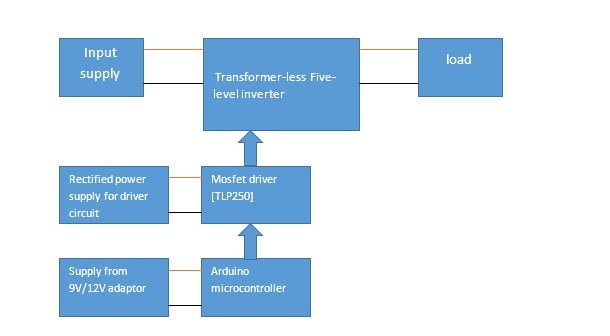
Block diagram explanation
- Input
Concept of this project mainly focus on renewable energy sources? like solar energy, fuelcell source etc.
- Main circuit
A new fundamental structure of a single phase transformer-less grid connected multilevel inverter based on a switched-capacitor structure
- Controller
Brain of the circuit, which will control all the? functions of the circuit, all the modes of this circuit perfectly achieved by the controller
- Feedback
For having a stabilized output closed loop data has selected which will transfer the instant values of output data? to the controller.
- Output
Delivering energy ports from the output of the circuit being used.
Modules
- Microcontroller(Arduino uno )
- Driver board[ there are two functions, one is to isolate the mosfet circuit from microcontroller and other is to amplify the signals from the microcontroller for mosfets]
- Driver board power supply[supply is taken from main power source by using transformer rectifier circuit]
- Supply for microcontroller[can take from us cables, or 9v, 12v adaptors should be used]
- Main power circuit(having active and passive componenets of different rating)
Circuit diagram
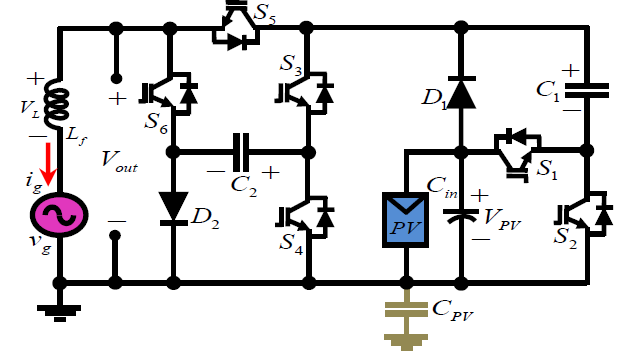
Pv voltage
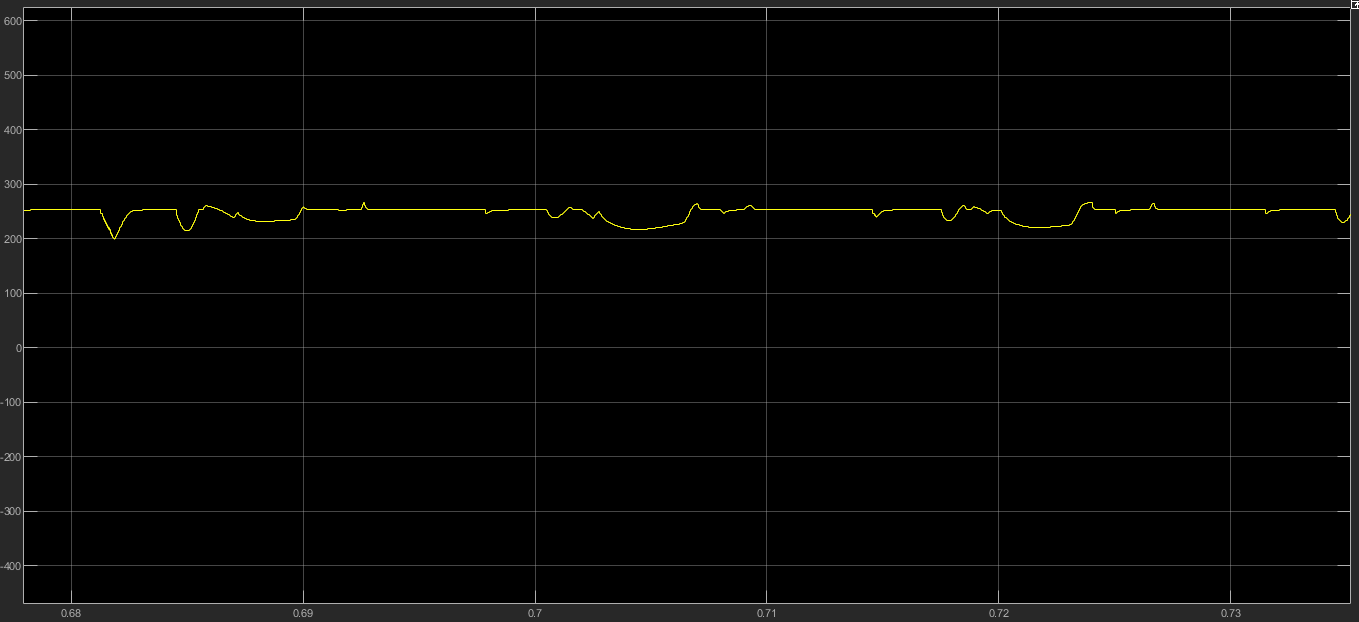
Grid voltage and current
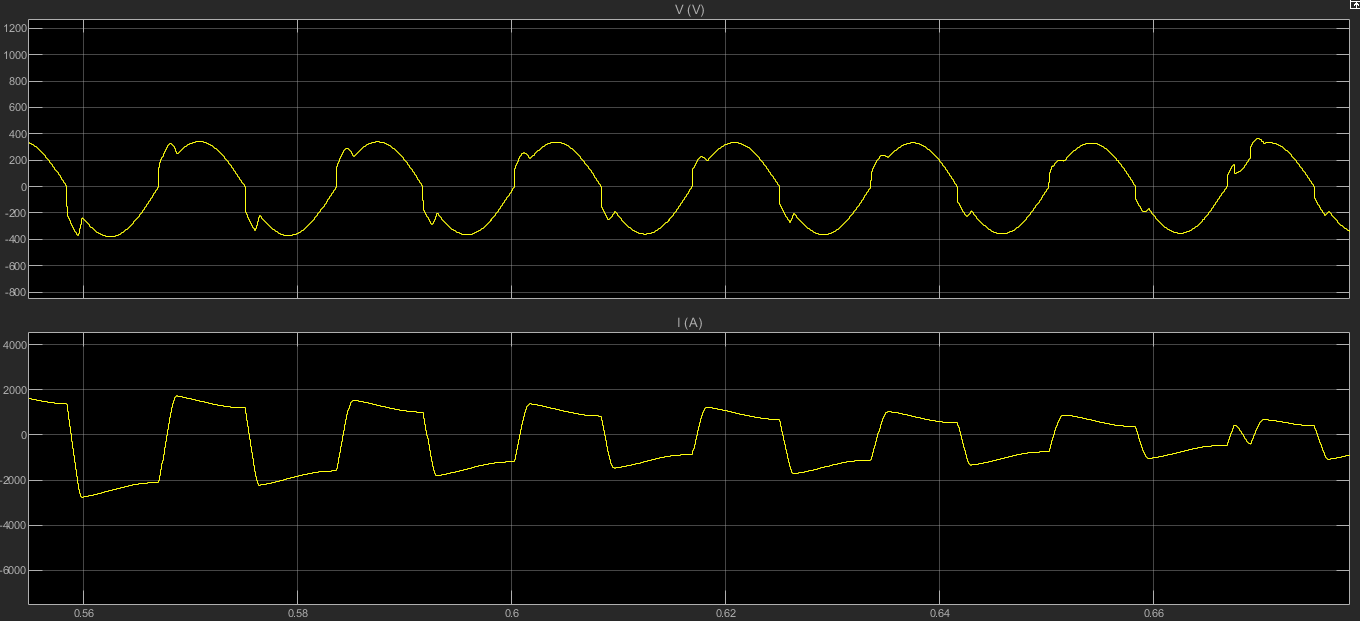
Inverter output voltage
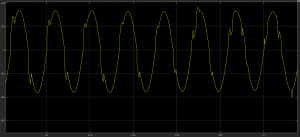
Literature survey
| S.NO | Title | Author name | Year of publish | Technology / algorithm used | Drawbacks |
| 1 | Novel transformerless grid connected power converter with negative grounding for photovoltaic generation system | J. M. Shen, H. L. Jou, and J. C. Wu | 2012 | The negative terminal of the solar cell array can be directly connected to the ground in the proposed grid-connected power converter to avoid the transparent conducting oxide corrosion that occurs in some types of thin-film solar cell array. The proposed grid-connected power converter consists of a dc?dc power converter and a dc?ac inverter. The salient features of the proposed power converter are that some power electronic switches are simultaneously used in both the dc?dc power converter and dc?ac inverter, and only two power electronic switches operate at high switching frequency at the same time (one is in the dc?dc power converter and the other is in the dc?ac inverter) | large volume, high weight, and high cost |
| 2 | Single phase transformerless inverter topologies for grid-tied photovoltaic system | M. Islam, S. Mekhilef, M. Hasan | 2015 | voltage buck-boost for maximum power point tracking (MPPT) allow numerous new topologies and configurations which are often confusing and difficult to follow when seeking to select the right topology. Therefore, to present a clear picture on the development of transformerless inverters for the next generation grid-connected PV systems, this paper aims to comprehensively review and classify various transformerless inverters with detailed analytical comparisons. To reinforce the findings and comparisons as well as to give more insight on the CM characteristics and leakage current | Flying capacitor or switched capacitor or flying inductor controlling is difficult. |
| 3 | A review of single-phase grid-connected inverters for photovoltaic modules | S. B. Kjaer, J. K. Pedersen, and F. Blaabjerg | 2015 | The inverters are categorized into four classifications: 1) the number of power processing stages in cascade; 2) the type of power decoupling between the PV module(s) and the single-phase grid; 3) whether they utilizes a transformer (either line or high frequency) or not; and 4) the type of grid-connected power stage. Various inverter topologies are presented, compared, and evaluated against demands, lifetime, component ratings, and cost. Finally, some of the topologies are pointed out as the best candidates for either single PV module or multiple PV module applications. | The drawbacks associated with it. The inverter must be designed to handle a peak power of twice the nominal power. which reason the minimum input voltage always must be larger than the maximum grid voltage |
Conclusion
The proposed grid-tied transformer-less topology can generate a multilevel waveform at the output voltage terminal which leads to a reduction in total harmonic distortion, a decrease in the effect of dv/dt and a reduction in the size and cost of output voltage filter. Moreover, by employing a peak current controller (PCC) strategy and utilizing a small inductor-based filter, a tightly controlled injected current can be obtained which is able to support both the active and reactive powers of the grid with a fast and robust dynamic response.
Reference
- M. Shen, H. L. Jou, and J. C. Wu, ?Novel transformerless grid connected power converter with negative grounding for photovoltaic generation system,? IEEE Trans. Power Electron., vol. 27, no. 4, pp. 1181?1829, Apr. 2012.
- Islam, S. Mekhilef, M. Hasan, ?Single phase transformerless inverter topologies for grid-tied photovoltaic system: A review,? Renewable and Sustainable Energy Reviews, vol. 45, pp. 69-86, 2015.
- B. Kjaer, J. K. Pedersen, and F. Blaabjerg, ?A review of single-phase grid-connected inverters for photovoltaic modules,? IEEE Trans. Ind. Applicat., vol. 41, no. 5, pp. 1292- 1306, Sep./Oct. 2005.





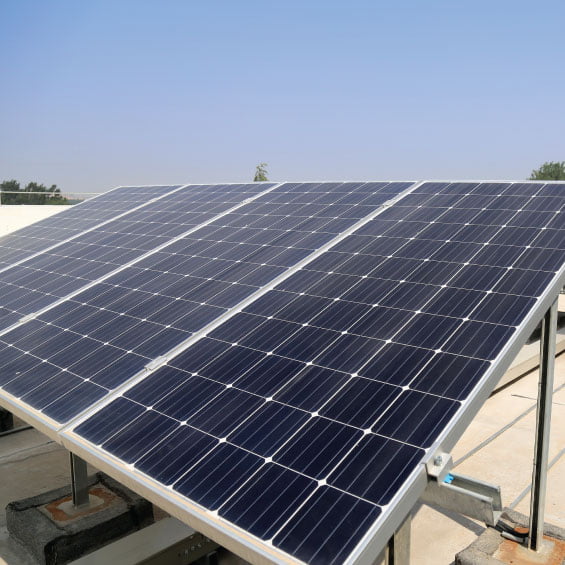

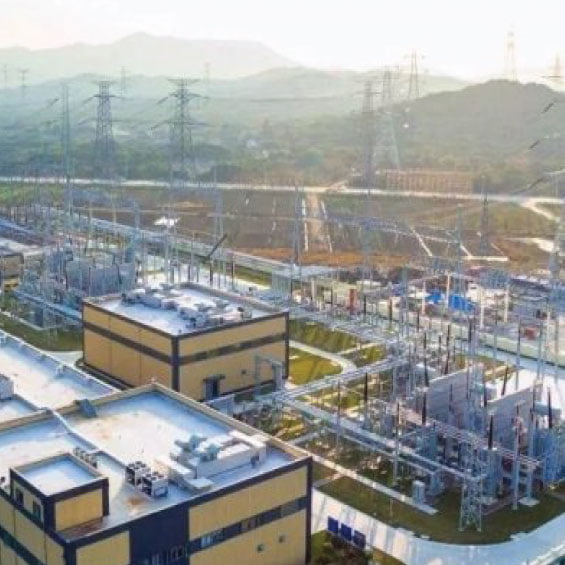





























































































































































































































































































































































































































































































































































































































































































































































































































































































































































































































































Customer Reviews
There are no reviews yet.